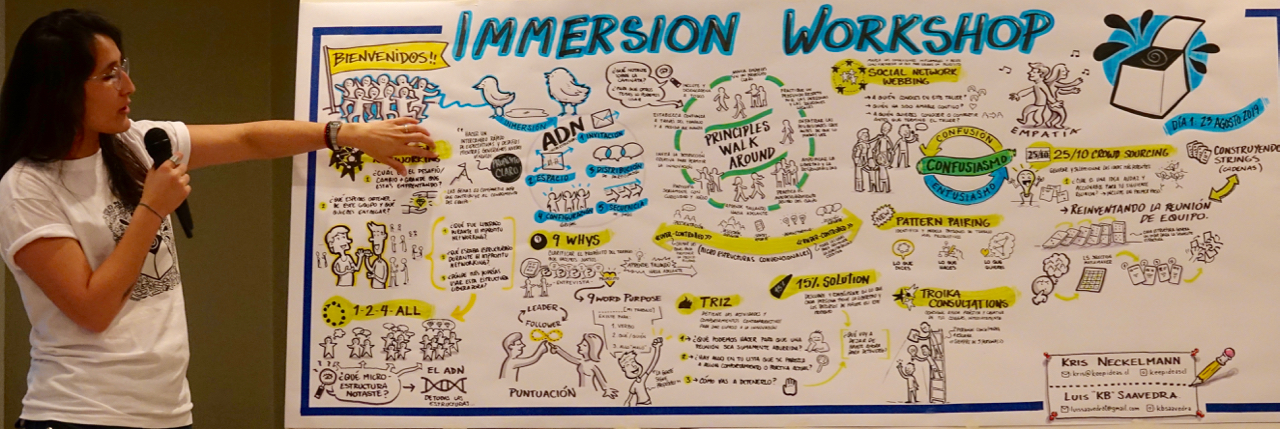In the last 12 months I’ve been involved in delivering five Liberating Structures immersion workshops in Sydney, Lima, Buenos Aires, Santiago and Auckland. I found them immensely educational, energising and fun. I’ve been thinking about the reasons for this and thought I’d share my thoughts with you, looking through a motivational lens.
What are Liberating Structures?
If you’re not familiar with Liberating Structures here’s a brief overview. They’re a set of 40 practical methods that help you include and unleash everyone —at all levels—in contributing their ideas in a safe, productive, and fun way. Each “Liberating Structure” introduces tiny shifts in the way you meet, plan, decide and relate to one another – and these tiny shifts (or microstructures) are deceptively easy-to-learn and straightforward!
Liberating Structures can bring more freedom, responsibility, and inclusiveness to routine meetings. People find themselves working at the top of their individual and collective intelligence when organising a movement, strategy-making, or transforming culture. The use of the structures boosts innovation when working across functions and disciplines on complex projects and initiatives.
Each micro-structure is designed to meet a specific purpose, and is structured by participation and time, for example:
- “Rapidly share challenges and expectations while building new connections“. This is the purpose of Impromptu Networking, involving pairs in three rounds taking a total of 20 minutes.
- “Engage everyone simultaneously in generating questions/ ideas/ suggestions“. This is the purpose of 1-2-4-All, involving individuals starting alone, then in pairs, then foursomes, and finally as a whole group in a total time of 12 minutes.
- “Stop counterproductive activities & behaviours to make space for innovation“. This is the purpose of TRIZ, involving groups of 4 to 7 in a process taking 35 minutes.
What is Self-Determination Theory?
Self-Determination Theory (SDT) is the leading theory of human motivation. SDT provides a framework for understanding the factors that promote human motivation and flourishing. In essence SDT states we all have basic psychological needs for autonomy, competence & relatedness. The originators of SDT, Edward Deci and Richard Ryan, define these as follows:
Autonomy is the basic need to be the author of one’s life —to have a sense of choice & self-endorsement of one’s actions. This need is fulfilled if we have a rationale & sense of purpose in what we are doing.
Relatedness is our basic need to feel we belong and “matter” to others. Each of us needs to feel connected in meaningful ways—to feel supported, valued, respected and included while experiencing that others need and value our support, value, respect and inclusion.
Competence is our basic need to feel effective, to be successful, and to grow. People want to feel they have what they need to succeed in their daily tasks, including the resources, skills, and expertise.
If all these needs are met the odds are you’ll be intrinsically (internally) motivated.
How Liberating Structures support intrinsic motivation
Liberating Structures are designed to support autonomy. As the examples above illustrate; each micro-structure has a clear purpose. As for choice: you choose to be involved; you choose whom you pair or form a small group with, and; you choose what you want to talk about.
A key objective of Liberating Structures is that “every voice gets heard” so there is an emphasis on supporting relatedness in having small groups where everyone gets to speak, and be heard. This is most explicit in the 1-2-4-All example above. Firstly you engage with yourself, then with someone else in a pair; then you join another pair and the four of you discuss before reporting back to the whole group. That’s four opportunities for your voice to be heard – in 12 minutes!
These micro-structures are deceptively easy-to-learn and straightforward; meeting your need for competence. On an immersion workshop, the aim is for participants to have the confidence to immediately begin to use Liberating Structures in their workplace. Henri Lipmanowiscz and Keith McCandless, the creators of Liberating Structures, and the community they have created are very generous in making many resources available to those learning and building their knowledge in this way of working with groups.
One of my most vivid experiences of how engaging Liberating Structures can be was when I used “25/10 Crowd Sourcing” with two groups of 30 – 40 coaches at an international conference in Warsaw. Few participants knew each other, yet at the end of the 30-minute process they were so engaged they wanted to continue through the break, and had connected to the extent they took a group photo. Yet the purpose of the micro-structure, “Rapidly generate and sift a group’s most powerful actionable ideas”, wasn’t specifically about connection or engagement.
I work with organisations so they can learn how to use Liberating Structures with their teams in meetings or events of any size. Contact me to discuss further.
For more information on the next Liberating Structures immersion workshop I’m delivering get in touch.

